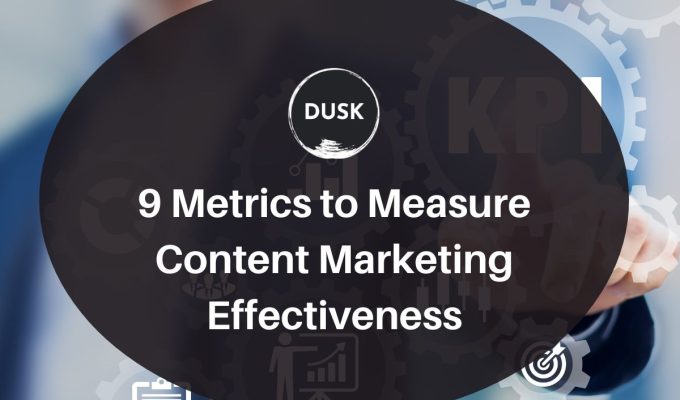Content marketing, on average, generates 3x as many leads as traditional advertising. That’s despite it costing 62% less!
However, how can you know if your content marketing strategy is effective? Fortunately, there are several KPIs (Key Performance Indicators) you can track to measure the effectiveness of your content marketing strategy. Using the following nine metrics, you’ll be able to determine whether you’re on the right track.
Many small businesses have challenges with their content marketing campaigns. The reason? It ain’t that easy!
1. Web Traffic
The easiest way to see if your content marketing strategy is working is to see if web traffic has increased.
Note that if you don’t see an immediate increase in web traffic after publishing your first few blog posts, that doesn’t necessarily mean your campaign isn’t effective. It takes time for content to start ranking and attracting organic traffic.
However, over the long run, you should be seeing more monthly visits than before you started publishing content. An easy way to track your traffic is by using Google Analytics. It will give you helpful insights about monthly visits and show you a historical graph, so you can get a quick picture of how your web traffic has increased or decreased over time.
2. Click-Through Rate
The second metric is your click-through rate. As you may expect, click-through rates vary based on ranking position, with the first position attracting a whopping 39.6% click-through rate, dropping to 18.4% for the second position and just 7.6% for the fourth position.
Using Google Search Console, you’ll be able to see your pages’ click-through rates. A poor click-through rate doesn’t necessarily mean the article isn’t good. It could mean that you need to do a better job optimizing the meta title and meta description. However, it could also mean that you are writing about the wrong topics.
Over time, your average click-through rate should be increasing. As your site grows and becomes more authoritative, your ranking positions should increase, bringing with them a better CTR overall.
3. Time on Page
Another important metric is how much time is spent on each page. The more time spent on page, the better.
If people are not spending a lot of time on your pages, the next step is to figure out why. A short time spent on page can show a lack of interest, and it can lead to fewer conversions, as people won’t have time to scroll down and see your call-to-action.
There are a few things that might cause people to leave a page early. If it’s a blog post, it might simply not be interesting enough. Perhaps you need to hire better writers, or perhaps you need to write about different topics or tweak the headline and subheadings to generate mystery and suspense.
Another possibility is that your page is hard to read. A lack of white space, images, and videos can lead to that. A poor user experience can also cause people to hit that X button. For example, pop-ups that are difficult to close or too many advertisements can frustrate people.
One way to get a closer look at the exact parts of your blog post that interest your users the most is to install a heatmap analytics program or plugin. That will show you where people are clicking on and where on your page they are scrolling to before leaving.
You may discover that people stop scrolling when they reach a certain section. Perhaps you went off on a tangent, discussing a topic that doesn’t concern them, or perhaps you started using language that is too advanced for your average reader to pay attention to.
4. Bounce Rate
Google Analytics will show you your bounce rate, which is the number of single-page sessions on your site. When users visit a page and then exit your site without visiting other pages, they “bounce” off your site.
Your goal should be to decrease your bounce rate as much as possible. A high bounce rate indicates that your site is uninteresting. The more pages people visit on your site, the more likely it is for a conversion to happen.
One way to increase your bounce rate is to start including more internal links in your content. Internal linking is beneficial for your SEO rankings as well. Including an easy-to-navigate menu can help as well, as can including a secondary menu of important pages in your sidebar.
One thing that can increase your bounce rate is having too many ads. When people click on an ad, they leave your site.
Also, when including outbound links, I recommend having them open in a new tab. That way, the tab with your site remains open, and people can go back and visit it easily.
5. Social Share
The number of social shares you are getting is a good indicator of how popular your content is as well. Start by looking at the number of shares each blog post is getting from the social sharing buttons you have added. Good social sharing plugins will have tracking capabilities, showing you how many times people shared your page on each of the linked platforms.
However, another indicator is how many shares your tweets and posts get when you publish a link to your blog post on social media. You might need to write better social media posts, include more hashtags, and optimize your title and social previews using plugins like Yoast.
6. Keyword Ranking
How well you are ranking for your target keywords is another big tell. Google values quality; we all know that. If your content is well-written, comprehensive, and helpful, it will rank better.
Sometimes, you might not rank well for your target keywords because you picked keywords that were too competitive. However, providing you have done your keyword research and chosen keywords with an easy or moderate ranking difficulty score, it’s a pretty good indicator of your content marketing strategy’s effectiveness.
Some reasons you might not be getting the rankings you think you deserve include:
- Not writing informative content
- Not having internal and external links
- Not doing on-page SEO
- Not optimizing your metadata
- Not including images and videos
- Not breaking down your article into paragraphs
7. Backlink
Getting backlinks, including local backlinks if you own a local business, is another good indication that your content is doing well. If people are linking to you without you even asking them, that shows you that your content provides value to people in your niche. It also means that other bloggers or local businesses see you as an authority.
If you are actively reaching out to other bloggers and asking for backlinks in exchange for guest posts or testimonials, having a good response rate shows you that when people look at your site, they see one chock-full of informative and helpful content.
8. Conversion Rate
Getting conversions on your website shows that your copywriting is paying off. It demonstrates that after reading your blog posts, people trust you enough to follow your calls-to-action. The way you insert your calls-to-action in your blog posts matters as well.
It doesn’t matter what type of conversion you’re tracking. Conversions can include:
- Email signups
- Ad clicks
- Phone calls
- Google Maps widget clicks
- Social media shares
- Purchases
- Affiliate signups
- Ebook downloads
- App downloads
- Software downloads
- Trial subscriptions
It’s not limited to sales. You need to figure out which conversions matter the most to you and use them as metrics to determine the effectiveness of your content marketing strategy. If your goal with a blog post is merely to get people to share it, that could be what you use. If your goal is to get people to sign up for a free trial, that’s the conversion you need to track.
You can track conversions using goals on Google Analytics. Here is a tutorial on how to do so.
9. Return on Investment
Finally, a simple way to see if your content marketing strategy is effective is to check the return on investment you’re getting from it. At the end of the day, it’s your bottom line that matters most. If your content is driving increased organic traffic and social shares, but you are seeing no difference in your ROI, you need to ask yourself why.
Perhaps you’re focusing on the wrong goals when writing your content. While you may be trying to avoid being pushy, you need to at least softly promote your products if you want to increase sales.
You don’t have to overdo it, but if you don’t include any links to your sales pages from your blog posts or insert tidbits explaining how your services or products can help, you may be leaving money on the table.
Final Thoughts
Things like comments on your blog posts also matter, but these nine metrics are the main ones to look at. You should be tracking these metrics and evaluating your progress every month to see how you have improved compared to the previous month. You can expect to have some months with decreased performance, so zoom out and look at your overall growth.






